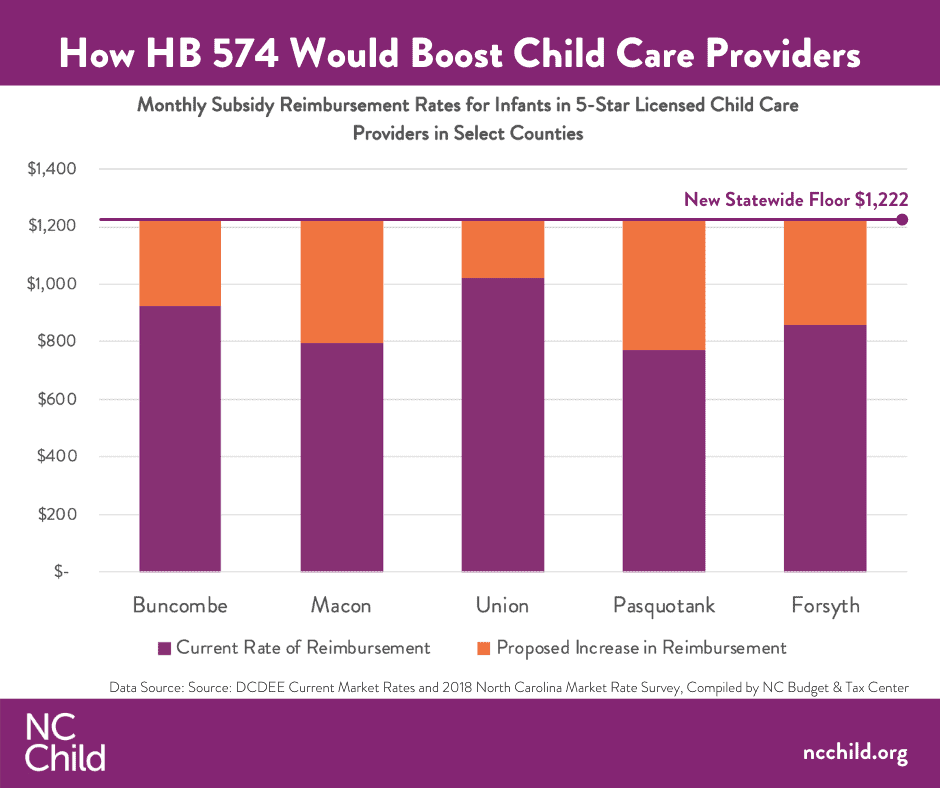Parents need choices for child care. Across the state, parents face a shortage of quality child care, which has been made worse by the pandemic. The American Rescue Plan has created a robust new funding stream for North Carolina to expand access and affordability for child care. There are several initiatives at the NC General Assembly this year focused on supporting the child care industry to get parents back to work, while getting great early education programs to more kids.
Here in western North Carolina, we’re particularly concerned about the outdated formula to compute rates used in the state’s child care subsidy program. This inequitable policy creates barriers for childcare providers, teachers, and families across the state.
Setting Smarter Rates
North Carolina’s child care subsidy program helps cover some of the costs of licensed early childhood education for more than 100,000 children each year. Child care providers in North Carolina are reimbursed for child care subsidy according to rates set by the NC General Assembly. The subsidy rates are based on county-specific market rates, which are determined from a statewide survey of private rates for child care. Subsidy rates vary by county, star level of the program, and the age of children served. Current rates are still based on 2015 data, even though the most recent survey was conducted in 2018.
Using different rates for each county creates major geographic inequities. Many child care providers in low-income and rural counties receive thousands of dollars less per month than in urban counties. As a result, child care programs are not financially viable, and there are not enough programs to meet the community need.
House Bill 574, with a bipartisan team of sponsors, indexes the rates to the 2018 data. The bill creates a new statewide floor to create a more equitable funding policy. This will help families in every county access quality child care close to home, while supporting local businesses.
Supporting the Workforce Behind the Workforce
Low subsidy rates are a long-standing problem. Most child care providers are small businesses operating at razor-thin margins. The pay for teaching staff is extremely low, and benefits are scarce. The average wage of a child care teacher in North Carolina is just $12/hour, despite the fact they have one of the most important jobs in our state.
An increased subsidy rate would allow providers to improve quality and availability for families. These could include increasing teacher pay & benefits, professional development, and more.
Child Care is Vital for Getting Families Back to Work
Families can’t go back to work without child care. However, the COVID-19 pandemic has put major pressure on our child care system. Providers are now facing increased costs, reduced revenues, and labor shortages as a result of the pandemic.
One-time relief funding has been vital to keeping providers – both centers and family child care homes – open during the pandemic. However, without significant long-term funding changes, it will be extremely difficult to build back a sustainable child care system that can actually meet families’ needs – especially in rural counties where providers are scarce, and the number of families who can afford to pay the full cost of care are fewer. This makes the average payment rates lower than in our more affluent urban counties.
Increasing the subsidy rates to the 2018 rates, and raising the floor on the rates to the statewide average, will help shore up the system and move toward greater sustainability over time. 98 counties would see increased investment under HB 574. Increasing the subsidy rate to the statewide average ensures providers in every county can stay open, offer more services, and provide high-quality learning to North Carolina’s youngest children.
Next Steps
HB 574 is a necessary interim step. North Carolina needs to develop a better method for calculating subsidy rates that reflects the true cost of high-quality child care. NC DHHS is planning to pursue an alternative methodology that will better align subsidy rates with the true cost of care. However, child care is essential for our economic recovery from COVID-19 – and this interim step to increase rates will help these vital small businesses stay open while benefiting family stability and child development.
Legislators are working on the state budget now. Call your legislator today to let them know that HB 574 should be included in our state’s fiscal plans.
Greg Borom is the Director of Advocacy at Children First / Communities in Schools of Buncombe County. Sheila Hoyle is the Executive Director of the Southwestern Child Development Commission.




